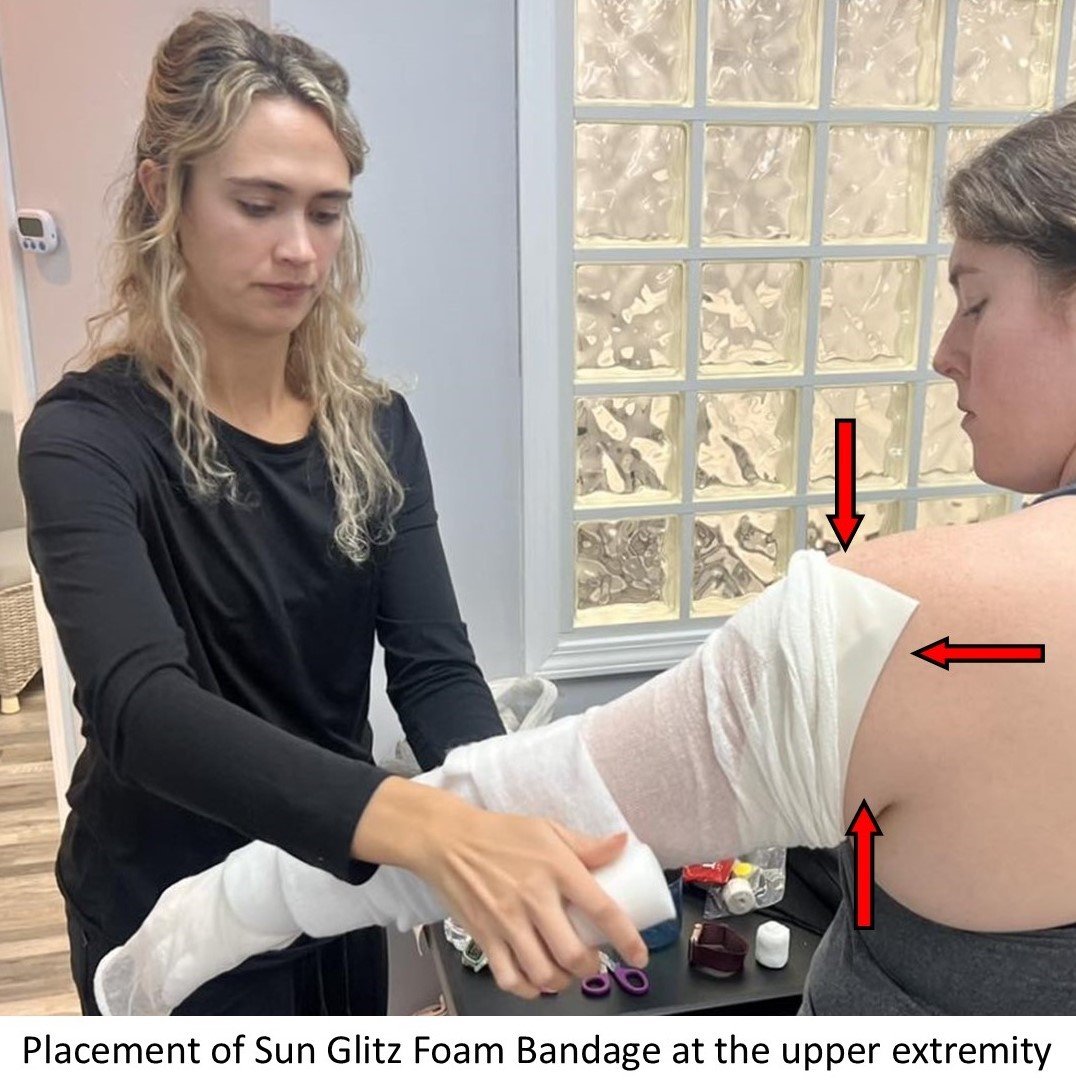Sun Glitz Foam Bandages: Your Solution For Preventing Lymphedema Bandaging Slippage
contributed by Brandy Mckeown OTR/L, CLT-LANA, CLWT
Solving The Issue Of Compression Bandaging Slippage
As a Certified Lymphedema Therapist and Training Instructor with the International Lymphedema & Wound Training Institute (ILWTI), and with over 20 years of hands-on experience as a lymphedema practitioner, I am constantly faced with the issue of how to prevent a multi-layer compression bandage from slipping down the affected limb after bandaging for lymphedema.
As part of our Certified Compression Specialist Course at the ILWTI, we teach our students how to master the application of a customized, full-limb, multi-layered compression bandaging system that will aggressively soften fibrotic tissue, will not slip down and will stay in place for several days at a time to ensure that the patient receives the appropriate compression therapy needed to address their medical condition. If the lymphedema bandage is not correctly applied or slips from its proper place, the lymphedema treatment will not be as effective, resulting in a longer duration of Complex Decongestive Therapy (CDT).
Therefore, in addition to teaching our students the proper application methods of multi-layer compression bandaging, we also review the factors which may cause the compression bandages to slip out of place. While a properly applied multi-layer compression bandage is designed to stay in place, slippage can sometimes still occur due to a variety of reasons:
- The padding layer of a multi-layer compression bandage helps the bandage adhere to the skin. If enough padding is not used, or padding coverage of the extremity is inadequate, it can contribute to slippage of the bandage.
- If the compression bandages are not applied correctly, for example too loosely, the multi-layer compression bandage will not provide sufficient compression and is more prone to slipping.
- If swelling of the affected limb decreases significantly during CDT treatment, the multi-layer compression bandage will begin to provide uneven pressure, can begin to loosen and ultimately the placement of the compression bandage can slip.
- A significant difference in circumference between the upper and lower areas of the affected limb (i.e., the limb has a conical shape) can make it harder for compression bandages to stay in place. This situation is more prevalent when the upper section of the limb is especially larger than the lower area, as gravity will constantly be working to pull the multi-layer compression bandage downward.
- If the compression bandages become wet or has an excessive accumulation of sweat, dirt, oils, or dead skin, the grip of the multi-layer compression bandage can loosen, causing it to slip out of place.
- Frequent movement or high levels of activity of the bandaged limb can cause the compression bandage to shift or slip out of place, particularly if the lymphedema bandage was not applied correctly.
- The lymphedema bandaging materials themselves may simply end up losing their elasticity and gripping properties over time and with extended use.
To help minimize the risk of the multi-layer compression bandages from shifting or slipping we teach our ILWTI students the following tips and techniques which will help to prevent slippage:
- Prior to bandaging for lymphedema ensure that the skin is clean and dry (but moisturized), before applying the multi-layer compression bandage.
- Use the correct bandaging materials including short stretch compression bandages with a textured fabric structure that will help each layer of the multi-layer compression bandage adhere to the next layer of bandage.
- Check the compression bandaging material to ensure that it is clean, oil free and structurally intact. Be sure to replace any lymphedema bandaging material that is old, dirty or which may have lost its inherent elasticity or gripping properties.
- If irregular body shapes, contours, or lobules are present, they will have to apply special wrapping techniques and custom solutions to help prevent the compression bandage from slipping.
- Ensure that each layer of the multi-layer compression bandage is applied with the right amount of stretch and overlap, paying special attention to wrinkles, creases or folds in the skin when wrapping.
- Secure the edges of the completed multi-layer compression bandage with bandage tape and medical tape to keep the bandages securely in place, prevent unraveling or slipping.
- Routinely change the compression bandages to accommodate changes in limb volume as the CDT progresses, and replace dirty or worn out bandaging material.
While all of these techniques will certainly help address the issue of slippage, throughout my career, I have always been on the look out for unique products which will provide that “extra” advantage to help keep the compression bandages in place. With the Foam Bandage by Sun Glitz I believe that I have found an excellent solution!
The Sun Glitz Foam Bandage offers a latex-free solution with adhesive properties (the Foam Bandage contains no actual adhesives) for helping to keep multi-layer compression bandages in place. The skin-friendly Sun Glitz Foam Bandage may be placed directly on the skin and sticks only to itself, not to the skin or hair. The soft, flexible properties of the Sun Glitz Foam Bandages makes them comfortable for the patient to wear (especially if they have sensitive skin), while providing a cushioning layer between the skin and the overlying compression bandages.
During the lymphedema certification training at the ILWTI we teach our students to use a small piece of the Sun Glitz Foam Bandage at the top of each multi-layer compression bandage to act as a form of “top band” to help keep the compression bandages in place. The students simply have to cut a small strip of the Sun Glitz Foam Bandage, wrap it around the upper extremity and directly on the skin of the limb being wrapped, as the initial step of lymphedema wrapping. As the layers of the multi-layer compression bandage are applied during the lymphedema bandaging, the adhesive properties of the Sun Glitz Foam Bandage will “grip” the over layer of the multi-layer compression bandage, helping it to stay in place.
The skin-friendly Sun Glitz Foam Bandage is non-constrictive and non-binding, easily conforms to body contours, provides cushioning and stays in place. Since the Foam Bandage can be easily removed, washed and reused, the same strip can be utilized multiple times as the multi-layer compression bandages are changed. The Sun Glitz Foam Bandage is truly a unique and economical solution for addressing the issue of slippage for lymphedema bandaging.
Another option for using the Sung Glitz Foam Bandage is to use it as an outer covering or protective layer for your multi-layer compression bandage. Using the Foam Bandage to wrap the completed multi-layer compression bandage will help keep the compression bandages clean and in place, and is especially useful in cases where extreme or irregular limb shapes make lymphedema wrapping difficult.


